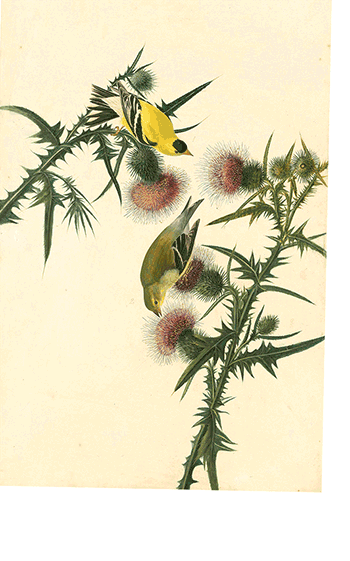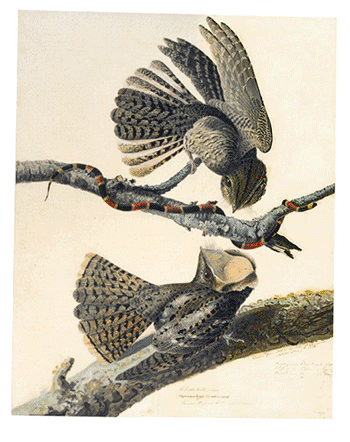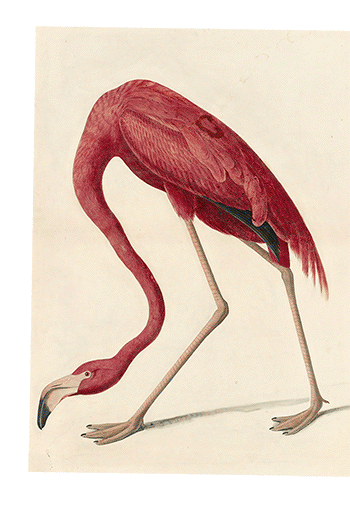Doubtless, the reader will say, while looking at the seven figures of Parakeets represented in the plate, that I spared not my labor. I never do, so anxious am I to promote his pleasure. —John James Audubon
Comparing two versions of the now extinct Carolina Parakeet—Mark Catesby’s 1771
engraving with John James Audubon’s 1825
plate—is to witness the inanimate come to life. Catesby follows a traditional eighteenth-century drawing style: a single bird, set in profile, against a blank background. [1] Audubon documents a visual breakthrough in ornithological illustration: his parakeets are drawn in context, in motion, and (seemingly) in collaboration. This is no flock fluke, as these parakeets could be found “climbing or hanging in every imaginable posture … [and] usually alight extremely close together,” [2] thus giving a more accurate behavioral representation.
From the singular to the singular sensation, this example parallels the impact that the digital humanities is having on academic study. It encourages collaborative projects over single authored ones; it broadens contexts through print and digital connectivity; and (like Audubon’s foreshortened parrot, staring straight at us) it engages with vast audiences, through digital networks and accessibility. This dynamic field breathes life into our interpretation of history, and the result is de-extinction. Through the emergence of the digital humanities, the humanities come alive with new research possibilities that enhance traditional methods of learning. Let’s see how Audubon’s work, in particular, can be reframed through this digital lens.
Audubon’s Birds of America comprises 435 engravings that represent 1,065 birds. His aviary offerings seem boundless, yet viewing this rare folio is limiting if only one plate at a time is displayed. What is lacking from this typical viewing experience is comparison. Pictures alone are merely pictures, “however when part of a sequence, a sequence of only two, the art of the image is transformed into something more” [3]—animation, illusion, interpretation. Finding correlations between plates, between plates and preparatory sketches, as well as texts, is instructive. However, if the material is too precious to display physically, then what are the digital assets that could supplement and enhance this type of display? Perhaps a dynamic table of contents; non-linear sorting (viewing pages based on similarity in composition, backgrounds, behaviors, bird size, etc.); annotations or audio; 3-D rendering or stacking; zoom and search functions; or juxtaposition for cross-referencing. These are methods for learning—there are surprises that transpire through these digital affordances; they are revealing and they ask us to reevaluate our expectations. Conceiving Audubon’s work comprehensively as a digital database would allow viewers, researchers, and teachers to “visually interpret, remap or reframe.” [4]
Did you know that Audubon published a
companion text whose title is as long as a flamingo’s neck:
Ornithological Biography, Or an Account of the Habits of the Birds of the United States of America: Accompanied by Descriptions of the Objects Represented in the Work Entitled The Birds of America, and Interspersed with Delineations of American Scenery and Manners. As the above suggests, this field guide is in direct dialogue with each plate, yet rarely are these documents displayed together.
What a design opportunity! How can digital technology integrate text and image? How can design unite two disparate manuscripts that were intended to be utilized together?
As revealed in an Audubon
exhibit at the New-York Historical Society, the artist made preparatory “watercolors” for each plate. Not mere sketches, but elaborate compositions that served as guides for replication. How do these drawings compare to their corresponding plate? What do their discrepancies reveal about the artistic contribution of Robert Havell, Jr. (or should we say Robert Havell, Genius?), the esteemed printer of Birds of America? And more importantly, how do these supplemental image and text collections cross-chronicle history?
The pièce de résistance comes at the moment the peacock displays his plumage: never before has there been a comprehensive display of watercolors with their corresponding plates. [5] Never before could we digitally layer the two for comparison. We have a “neural network for the concept of comparison.” [6] Juxtaposition produces immediate cognitive effects, as evidenced in the following GIF animations. From this unique digital perspective, collaborative efforts unfold and questions arise.
Indeed, this is a “galvanizing moment to be a humanist involved in devising, designing, and deploying new tools; in opening expanded modes of inquiry unthinkable under pre-digital conditions…through the as-yet-unrealized possibilities of digital platforms.” [7] History touts Audubon as the single auteur—a solitary bird. Comparisons reveal otherwise. His work was part of a flock. So if history gives you the bird, redefine it, digitally, as a mother flocker.
American Flamingo | watercolor with plate 431
This is an exacting comparison of the flamingo’s shape and size. Such fidelity to form is common throughout most of Audubon’s watercolor to plate comparisons, suggesting that tracing methods were employed.* The background has been added as well, which was the artistic contribution of the engraver (the aforementioned Havell), but how was it art directed, if at all?
* 1 Susanne M. Low, An Index and Guide to Audubon’s Birds of America (New York: American Museum of Natural History, 1988).

Great White Heron | watercolor with plate 281
How do you create a three-dimensional space on a two-dimensional surface? Margins that tightly crop the composition force the heron’s bill to extend the frame. This strategy reveals Havell’s genius, as it causes the heron to jump off the page. Furthermore, visual perception tells us that if the bill extends the margin, then the fish must invade the viewer’s space. We’re witnessing a magical three-dimensional moment. Can we attribute these decisions solely to Havell?

Golden Eagle | watercolor with plate 181
Again, three-dimensionality is achieved by extending the eagle’s beak and feathers outside the composition. The suggestion of flight is further enhanced by shifting the bird vertically (and conversely, lowering the mountainous background). There is a noticeable omission of the background figure, Audubon himself supposedly, who had been drawn crossing a fallen tree. What was the reason for this omission?

American Goldfinch | watercolor with plate 33
The America Goldfinch comparison quickly reveals an additional thistle branch. Can we presume that this change is meant to simply fill space?

Wild Turkey (female and young) | watercolor with plate 6
Unlike the rest, this plate was originally engraved by W. H. Lizars and then retouched by R. Havell, Jr. Significant changes are evident between the two Wild Turkey Female compositions. The context shifts from being hidden in foliage (watercolor) to full exposure (plate). This happens through the elimination of the upper background. Where once the environment is full-bleed, now it becomes vignetted. Was this a decision to help delineate the form of the mother turkey, so she is contrasted and not camouflaged?

American White Pelican | watercolor with plate 311
Dramatic changes to the background are evident: a shift from mid-tones to dark creates a brooding night scene. Is this merely the result of a deeply bitten copper plate or was it intentional to alter the mood?

Chuck-will’s Widow | watercolor with plate 52
“The Chuck-will’s-widow manifests a strong antipathy towards all snakes, however harmless they may be.”* Comparison reveals that this frightened and hissing female bird along with her support branch is lowered on the plate. The addition of a vine (Bignonia Capreolata?) separates her from the “harmless Harlequin” snake (in actuality it may be a copperhead). Audubon doesn’t mention this vine in the “Ornithological Biography.” Was this addition merely formal, made to lighten up the overall brown composition with green and red? Perhaps not. Seeing that the red flowers on the vine perfectly match the red segments on the snake, camouflaging the snake from the viewer, this change probably had motive: The snake now emerges last, surprisingly, and the viewer shares the same emotion as this bird.
*John James Audubon,
Ornithological biography, accessed online at the Darlington Digital Library, University of Pittsburgh.
___
[1] Lee A. Vedder, John James Audubon and The Birds of America: A Visionary Achievement in Ornithological Illustration (San Marino, CA: Huntington Library, 2006).
[2] John James Audubon and William MacGillivray, Ornithological biography or an account of the habits of the birds of the United States of America; accompanied by descriptions of the objects represented in the work entitled The Birds of America, and interspersed with delineations of American scenery and manners (Edinburgh: A. Black, 1831–1849).
[3] Scott McCloud, Understanding Comics, (New York: HarperPerennial, 1994).
[4] Anne Burdick, Johanna Drucker, Peter Lunenfeld, Todd Samuel Presner, and Jeffrey T. Schnapp, Digital_humanities (Cambridge, MA: The MIT Press, 2012).
[5] Initiated in the spring of 2014, the New-York Historical Society is showcasing a comprehensive exhibit of Audubon’s watercolors—in three parts—entitled Audubon’s Aviary: The Complete Flock, which offers various watercolor to plate comparisons. The next and final installment of this three-part exhibit opens next year.
[6] James E. Zull, The Art of Changing the Brain: Enriching Teaching by Exploring the Biology of Learning (Sterling, VA: Stylus Pub., 2002).
[7] Burdick, et al., 2012.
___
A kind thank you is extended to Michael Dabrishus, Joseph Goddu, and Roberta Olson for their generous and scholarly answers to my inquiries.
Digital watercolors are from the collection at the New-York Historical Society.
Digital plates are from the University of Pittsburgh, viewed through commons.wikimedia.org.
















